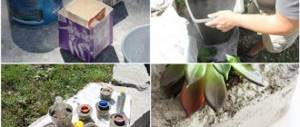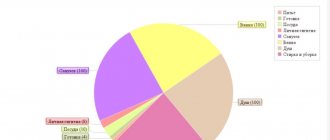This term has other meanings, see Cement (meanings).
A mortar prepared from cement in a concrete mixer is loaded into a wheelbarrow.
Cement
(Latin caementum - “crushed stone, broken stone”) - an artificial inorganic hydraulic binder. One of the main building materials. When interacting with water, aqueous solutions of salts and other liquids, it forms a plastic mass, which then hardens and turns into a stone-like body. Mainly used for making concrete and mortars. Cement is a hydraulic binder and has the ability to gain strength in wet conditions, which is fundamentally different from some other mineral binders (gypsum, airborne lime), which harden only in air.
Cement grade is a conditional value that means that the compressive strength will not be lower than the designated grade (200, 300, 400, 500, 600)
Cement for mortars
- low-clinker composite cement intended for masonry and plaster mortars. They are made by grinding together Portland cement clinker, active mineral additives and fillers.
Historical information
Mixing
The Romans mixed certain materials into lime to give it hydraulic properties. These were:
- pozzolans (volcanic ash deposits from Vesuvius);
- crushed or crushed bricks;
- tracks they found in the Eifel area (hardened deposits of volcanic ash).
Despite the differences, all these materials contain oxides: silicon dioxide SiO2 (quartz or silicic acid), aluminum oxide Al2O3 (alumina), iron oxide Fe2O3 - and cause lime to interact with them; in this case, water is added (hydration) with the formation, first of all, of compounds with silica. As a result, insoluble calcium hydrosilicates crystallize. In the Middle Ages, it was accidentally discovered that the products of firing limestone contaminated with clay were not inferior to Roman pozzolanic mixtures in water resistance and even surpassed them.
Mortar mixer for underground concrete work
After this, a century-long period of intense experimentation began. At the same time, the main attention was paid to the development of special deposits of limestone and clay, to the optimal ratio of these components and the addition of new ones. Only after 1844 did they come to the conclusion that, in addition to the exact ratio of the components of the raw mixture, a high firing temperature (about +1450 ° C, 1700 K) was first of all necessary to achieve a strong connection of lime with oxides. These three oxides, after sintering with lime, determine the hydraulic properties; they are called oxides that cause hydraulicity (hydraulicity factors).
Portland cement is obtained by heating limestone and clay or other materials of similar gross composition and sufficient activity to a temperature of +1450...+1480 °C. Partial melting occurs and clinker granules are formed. To obtain cement, clinker is ground together with approximately 5% gypsum stone. The gypsum stone controls the rate of setting; it can be partially replaced by other forms of calcium sulfate. Some specifications allow the addition of other materials during grinding. A typical clinker has an approximate composition of 67% CaO, 22% SiO2, 5% Al2O3, 3% Fe2O3, 3% other components and usually contains four main phases called alite
,
belite
,
aluminate phase and aluminoferrite phase
. Several other phases, such as alkali sulfates and calcium oxide, are usually present in clinker in small quantities.
Alite is the most important constituent of all conventional cement clinkers; its content is 50-70%. This is tricalcium silicate, Ca3SiO5, the composition and structure of which is modified due to the placement of foreign ions in the lattice, especially Mg2+, Al3+ and Fe3+. Alite reacts relatively quickly with water and in normal cements, of all phases, plays the most important role in the development of strength; for 28-day strength, the contribution of this phase is especially important.
The belite content for normal cement clinkers is 15–30%. It is a dicalcium silicate Ca2SiO4, modified by the introduction of foreign ions into the structure and usually completely or mostly present in the form of a β-modification. Belite reacts slowly with water, thus having little effect on strength during the first 28 days, but significantly increases strength in later periods. After a year, the strengths of pure alite and pure belite under comparable conditions are approximately the same.
The aluminate phase content is 5-10% for most normal cement clinkers. This is tricalcium aluminate, abbreviated as 3CaAS (composition - 3CaO*Al2O3*SiO2), significantly changed in composition, and sometimes in structure, due to foreign ions, especially Si4+, Fe3+, Na+ and K+. The aluminate phase reacts rapidly with water and can cause undesirably rapid setting unless a setting control agent, usually gypsum, is added.
The ferrite phase makes up 5-15% of ordinary cement clinker. This is tetracalcium aluminoferrite, abbr. 4СaAFS (4CaO*Al2O3*Fe2O3*SiO2), the composition of which changes significantly when the Al/Fe ratio changes and the placement of foreign ions in the structure. The rate at which the ferrite phase reacts with water may vary somewhat due to differences in composition or other characteristics, but is generally high early on and intermediate between the rates of alite and belite later in life.
The outstanding scientific chemist Alexey Romanovich Shulyachenko is considered the father of the Russian cement industry. The Antonov shaft kiln is widely used for firing and clinker production. Yu. M. Butt, S. M. Royak, I. F. Ponomarev, N. A. Toropov and others carried out a lot of work on issues of cement technology and hardening of hydraulic binders.
Cement production in factories
Specialized enterprises are engaged in the production of cement mixtures. To obtain a high-quality product, special equipment and knowledge of technology are required. The choice of cement production method depends on the capacity of the enterprise and the quality of raw materials.
The technological process involves performing a number of production stages:
- Extraction of raw materials, which include gypsum, clay, limestone. Crushing limestone and giving the resulting product the necessary moisture. Limestone grinding. Mixing it with clay. The concentration of components may vary. It all depends on the characteristics of the raw materials used. Basically the ratio is 3:1. The result is a combined, dry or wet sludge. Burning. The raw material mass is sent to a furnace heated to 1500 degrees, where it is sintered and turned into a granular fraction - clinker. Grinding. The clinker is crushed into powder in special mills. The prepared ingredients are mixed in accordance with the recipe for the brand of future cement. During the mixing process, gypsum and special mineral additives are added.
Currently reading: How to screw a self-tapping screw into concrete
Cement compositions are made using proven technologies. Depending on the composition and quality of the raw materials used, different methods of preparing starting materials are used.
Dry method
No water is used in production. The main materials are clay and limestone, crushed using special equipment. Dried and ground into flour. Mixed using a pneumatic tool and fed for firing.
The clinker formed after firing is crushed to a specified fraction, packaged in prepared containers and transported to a warehouse. Producing cement using the dry method reduces production costs. But it requires increased homogeneity of the base materials. In addition, it is dangerous from an environmental point of view.
Wet method
The advantage of this method of cement production is the ability to accurately select the required slurry composition, despite the heterogeneity of the feedstock. With this method, the sludge acquires a liquid consistency. It contains about 40% liquid.
Before making the final product, the sludge is placed in special process tanks to adjust the composition. Then it is sent to rotary kilns for firing.
The firing temperature exceeds 1000 degrees, so producing cement using the wet method requires a lot of energy. But it makes it possible to obtain a high quality product.
Combined methods
The technology involves combining dry and wet methods of cement production. One of them can be taken as a basis, and the second can act as an addition. These methods differ at different enterprises. It all depends on the characteristics of the existing equipment for cement production, proximity to the place of extraction of raw materials, as well as on the needs for established brands of product.
If the wet method is used as a basis, the raw materials are first mixed and then dehydrated in special dryers with filters to an almost dry state. Only after this procedure is it sent to the oven. This technology allows to reduce heat consumption, since there is almost no evaporation during the firing process.
When the dry method is used, water is used in the process of granulating the finished mixture. In both cases, the humidity of the clinker going into the kiln is about 10-18%.
Types of cement
Based on the presence of the main mineral, cements are divided:[1]
- Roman cement - predominance of belite, not currently produced;
- Portland cement - predominant alite, most widely used in construction;
- aluminous cement - predominance of the aluminate phase;
- magnesia cement (Sorel cement) - based on magnesite, mixed with an aqueous solution of salts;
- acid-resistant cement - based on sodium hydrosilicate (Na2O m
SiO2
n
H2O), a dry mixture of quartz sand and sodium silicofluoride, sealed with an aqueous solution of liquid glass.
Biocement is also known, which differs from conventional cement in that it is produced using biotechnology.
In the vast majority of cases, cement refers to Portland cement and cements based on Portland cement clinker. At the end of the 20th century, the number of varieties of cement was about 30.[1]
Based on strength, cement is divided into grades, which are determined mainly by the compressive strength of halves of prism samples measuring 40x40x160 mm, made from a 1:3 cement solution with quartz sand. Grades are expressed in numbers M200 - M600 (usually in increments of 100 or 50), indicating compressive strength of 100-600 kg/cm² (10-60 MPa), respectively. Due to its strength, cement with grade 600 is called “military” or “fortification” and costs significantly more than grade 500. It is used for the construction of military facilities, such as bunkers, missile silos, and so on.
Currently, cement is divided into classes based on strength. The main difference between classes and brands is that strength is not derived as an average indicator, but requires at least 95% assurance (that is, 95 samples out of 100 must correspond to the declared class). The class is expressed in numbers 30-60, which indicate compressive strength (in MPa).
Production technology
Cement production technology consists of two main stages. At the first stage, an intermediate product is obtained - clinker, granules heated to 1500 ° C, obtained from lime and clay. This is the basis for the future of cement. In the second stage of production, the clinker is crushed together with gypsum or other additives to produce Portland cement.
In the cost of finished products, the costs of the first stage of production reach 80%.
Video technology:
In the production of cement, it is necessary to take into account the composition of raw materials according to chemical and mineralogical indicators: homogeneity, hardness. These indicators can vary greatly even in raw materials from the same deposit, and even more so from different quarries. In addition, raw materials may differ in such parameters as humidity and purity, and depend on mining conditions, methods of transportation and storage of raw materials. And as a result of this, the method of cement production must be chosen.
There are three methods in total: “wet”, “dry” and combined.
- The “wet” method of producing cement is a process in which the grinding of the prepared raw material mass occurs in water, resulting in a mixture of mixed ingredients, presented in the form of a suspension, sludge, and with a moisture content of 30 to 50%.
- With the “dry” method of cement production, as its name implies, no water is used; the mixture in this case is a finely ground powder, the ingredients of which are specially dried before use.
- With a combined method of cement production, the output is a mixture with a moisture content of up to 20%. The basis for this method is either the “dry” method or the “wet” one. With the basic “dry” process, the process is as follows: the prepared raw material mixture is granulated, adding 10-14% water to it. If the basic method is “wet” - at the output, the resulting sludge is forcibly dried with special filters to a moisture content of 16-18%. As a result of using a combined method, clinker is fired in the form of granules, 10-15 mm in size, or a paste-like mass.
Of course, different equipment is used for each method.
Production
Cement is obtained by finely grinding clinker and gypsum. Clinker is a product of uniform firing before sintering a homogeneous raw material mixture consisting of limestone and clay of a certain composition, ensuring the predominance of calcium silicates.
When grinding clinker, additives are introduced: gypsum CaSO4 2H2O to regulate the setting time, up to 15% active mineral additives (pyrite cinders, flue dust, bauxite, sand) to improve some properties and reduce the cost of cement.
The raw mixture is fired at a temperature of +1450...+1480 for 2-4 hours in long rotary kilns (3.6×127 m, 4×150 m and 4.5×170 m) with internal heat exchange devices to simplify the synthesis of the necessary cement clinker minerals. Complex physical and chemical processes occur in the fired material. The rotary kiln can be divided into zones:
- heating (+200...+650 °C - organic impurities burn out and the processes of dehydration and decomposition of the clay component begin). For example, the decomposition of kaolinite occurs according to the following formula: Al2O3 2SiO2 2H2O → Al2O3 2SiO2 + 2H2O; further, at temperatures +600…+1000 °C, aluminosilicates decompose into oxides and metaproducts.
- decarbonization (+900…+1200 °C) decarbonization of the limestone component occurs: CaCO3 → CaO + CO2, while the decomposition of clay minerals into oxides continues. As a result of the interaction of basic (CaO, MgO) and acidic oxides (Al2O3, SiO2) in the same zone, processes of solid-phase synthesis of new compounds begin (CaO Al2O3 is an abbreviated form of SA, which at higher temperatures reacts with CaO and at the end of liquid-phase synthesis is formed C3A), proceeding in steps;
- exothermic reactions (+1200...+1350 °C) the process of solid-phase sintering of materials is completed, here the process of formation of such minerals as C3A, C4AF (F - Fe2O3) and C2S (S - SiO2) - 3 of the 4 main minerals of clinker - is completed;
- sintering (+1300 → +1480 → +1300 °C) partial melting of the material, clinker minerals pass into the melt except C2S, which, interacting with CaO remaining in the melt, forms the mineral alit
(C3S - solid solution of tricalcium silicate and a small amount (2- 4%) MgO, Al2O3, P2O5, Cr2O3 and others); - cooling (+1300…+1000 °C) the temperature decreases slowly. Part of the liquid phase crystallizes with the release of crystals of clinker minerals, and part freezes in the form of glass.
Cement composition
The cement mixture is obtained by mixing a number of components:
- Clinker. The substance is based on clay and limestone and is used to determine the strength of a material. Produced by firing clay and limestone. Under the influence of high temperatures it melts, transforming into a granular fraction with a high silica content. Then it is fired again. Plaster. Used to regulate the cement hardening process. It is introduced into the composition in an amount of no more than 5%. Active mineral supplements. They help improve the properties of the cement composition and expand the scope of its use.
In the manufacture of products, other additives can be used, for example, oxides of calcium, magnesium, phosphorus, and salts. But they are used in small quantities. They are added in order to obtain established characteristics - heat resistance, acid resistance, etc.
If the technological process allows, then plasticizers can be introduced into the composition.
Their use helps to obtain the following performance characteristics:
- Prevent moisture from penetrating into the structure. Reduced hardening time. Increased strength. Resistance to temperature fluctuations and the influence of aggressive environments.
Depending on the amount of additives, several types of product are distinguished:
- Portland cement. The most common modification, which contains about 80% calcium silicate. Used in various construction works. The addition of coloring substances improves the decorative properties of cement, allowing it to be used for finishing work. Aluminous. Characterized by accelerated hardening. Thanks to this property, it is used on objects that require urgent restoration, for example, eliminating damage after accidents or fires. Magnesian. The main component is magnesium oxide, which adds strength to the composition and increases adhesion to wood. However, due to its increased susceptibility to corrosion, it is rarely used. Acid resistant. During the manufacturing process, a filler is added to the composition - sodium hydroxylicate, which is sealed with liquid glass. Used in acid-resistant concrete and mortars.
World cement production
In 2010, global cement production reached 3.325 billion tons. The three largest producers included China (1.8 billion tons), India (220 million tons), and the USA (63.5 million tons). According to Rosstat, production in Russia of Portland cement, aluminous cement, slag cement and similar hydraulic cements in 2012 amounted to 61.5 million tons.
The largest cement producers in the world for 2011[2]:
- Holcim - Switzerland - 136.7 million tons
- Lafarge - France - 150.6 million tons
- Heidelberg Group - Germany −176 million tons (as of July 1, 2020)
- Cemex - Mexico - 74.0 million tons
- Italcementi - Italy - 54.4 million tons
- Anhui Conch Cement - China - 41.5 million tons
- Taiheiyo Cement - Japan - 38.0 million tons
- Votorantim Cimentos - Brazil - 31.8 million tons
- Buzzi Unicem+Dyckerhoff - Italy-Germany - 26.6 million tons
- Cimpor - Portugal - 28.3 million tons
- Vicat - France - 19.8 million tons[3]
- Eurocement group - Russia - 18.4 million tons
Cement production in Russia
Ten leading cement producers in Russia for 2013 (volume in million tons / market share in %)[4]:
- Eurocement group - 21,649 / 32.6
- Novoroscement - 5.772 / 8.7
- "Mordovtsement" - 4.717 / 7.1
- "Siberian Cement" - 4.307 / 6.5
- Heidelberg Cement - 3.654 / 5.5
- Holcim - 3.658 / 5.5
- Dyckerhoff - 3.257 / 4.9
- Sebryakovcement - 3.167 / 4.8
- Lafarge - 2.416 / 3.6
- "Vostokcement" - 2.037 / 3.1
Design capacity of the plants at the end of 2014 (million tons per year):
- "Eurocement group" - 33.1
- "Mordovcement" - 7.2
- "Novoroscement" - 6.9
- "Siberian Cement" - 6.7
- Heidelberg Cement - 4.9
- Holcim - 4.6
- "Vostokcement" - 4.3
- Dyckerhoff - 3.7
- "Sebryakovcement" - 3.4
- "Bazelcement" - 3.2
In December 2014, Mordovcement enterprises came under the control of Eurocement Group.[5]:
Dry method of cement production
The diagram for producing cement using the dry method is shown in the figure below.
During the production of cement using the dry method, a different technological scheme is used. Clay and limestone extracted from the quarry, after crushing, are sent to a separator mill, where the raw materials are ground, mixed and dried. The resulting mixture is sent to mixing devices, where final mixing is performed using compressed air. At this stage, the chemical composition of the cement mixture is adjusted.
If a clay component is used, the raw material mixture is fed into augers for mixing, in which partial moistening occurs with water. At this stage, strong granules are formed that have a moisture content of no more than 14% - then they enter the kiln for firing.
With the dry production method, the process of firing raw materials can be carried out in various furnaces, here special attention is paid to the preparation of the raw material mass. Further stages of the technological process are carried out in the same way as with the wet production method.
Notes
- ↑ 12
Construction materials science: A textbook for construction specialists. universities / I. A. Rybyev. - M.: Higher. school, 2003. - 701 p. - Vladimir Kondratyev
- [World Cement Industry], Perspectives Portal, 2011 - Vicat Group by the numbers.
- Top 10 largest cement producers in Russia, Kommersant, April 8, 2014.
- Independent construction portal. Top 10 cement producers in Russia. 02/25/2015.











